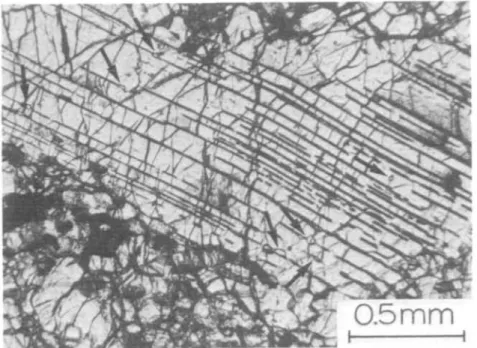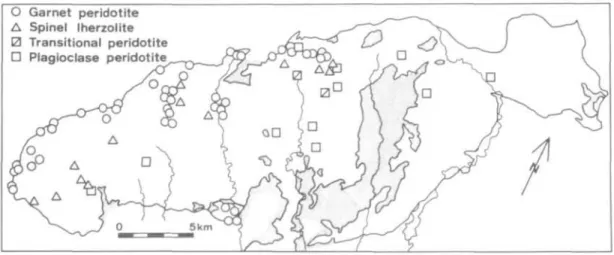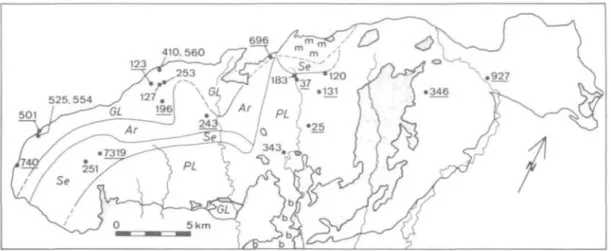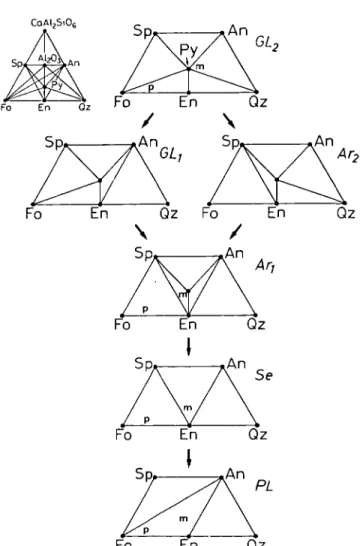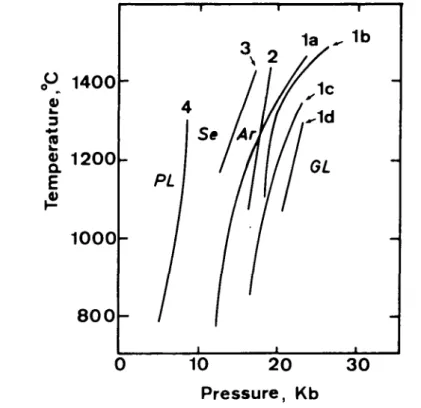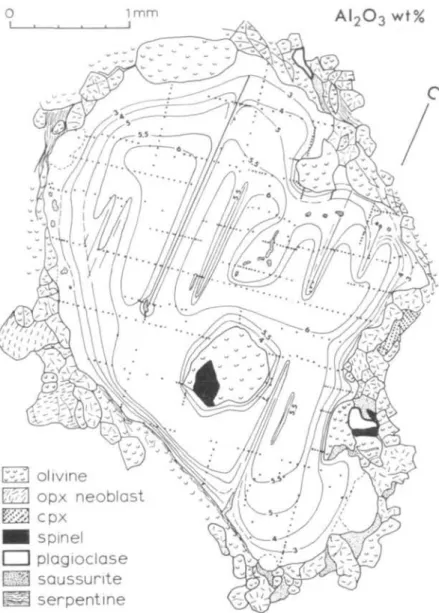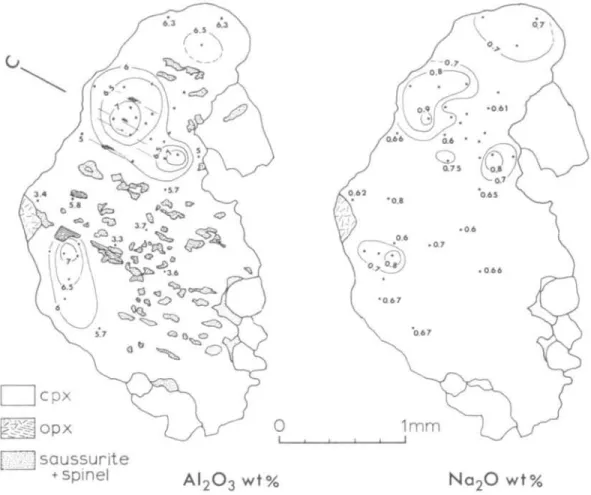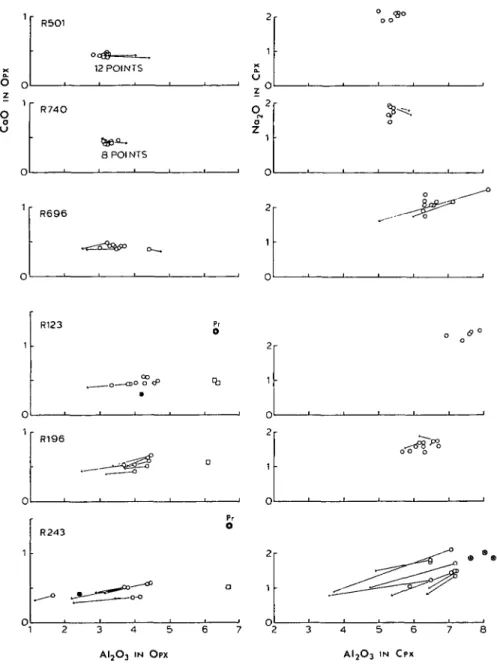Research Collection
Journal Article
The Ronda Peridotite: Garnet-, Spinel-, and Plagioclase-
Lherzolite Facies and the P-T Trajectories of a High-Temprature Mantle Intrusion
Author(s):
Masaaki, Obata Publication Date:
1980
Permanent Link:
https://doi.org/10.3929/ethz-b-000422842
Originally published in:
Journal of Petrology 21(3), http://doi.org/10.1093/petrology/21.3.533
Rights / License:
In Copyright - Non-Commercial Use Permitted
This page was generated automatically upon download from the ETH Zurich Research Collection. For more information please consult the Terms of use.
ETH Library
The Ronda Peridotite: Garnet-, Spinel-, and
Plagioclase-Lherzolite Facies and the P—T Trajectories of a High-Temperature Mantle Intrusion
by MASAAKI OBATA*
Institutfiir Kristallographie und Petrographie, Eidgenossische Technische Hochschule, Zurich, CH-8092, Zurich, Switzerland
(Received 18 October 1978; in revised form 28 June 1979)
A B S T R A C T
The Ronda peridotite is a high-temperature, alpine-type peridotite emplaced in the internal Zone of the Betic Cordilleras, southern Spain. Using the mineral assemblages of the peridotite and mafic layers, the peridotite mass has been subdivided into 4 zones of mineral facies: (l)garnet-lherzolite facies, (2) ariegite subfacies of spinel-lherzolite facies, (3) seiland subfacies of spinel-lherzolite facies, and (4) plagioclase-lherzolite facies. It is proposed that this mineralogical zonation developed through a syntectic recrystallization of a hot (1100 to 1200 °C), solid mantle peridotite during its ascent into the Earth's crust.
Coexisting minerals from 12 peridotites covering all the mineral facies above were analysed with an electron microprobe. Core compositions of pyroxene porphyroclasts are constant in all mineral facies and indicate that the peridotite was initially equilibrated at temperatures of 1100 to 1200 °C and pressures of 20 to 25 kb. In contrast, the compositions of pyroxene neoblasts and spinel grains (which appear to have grown during later recrystallization) are well correlated with mineral facies.
They indicate that the recrystallization temperature throughout the mass is more or less constant, 800 to 900 °C, but that the pressure ranges from 5-7 kb in the plagioclase-lherzolite facies to 12-15 kb in the garnet-lherzolite facies. Therefore, variation in pressure appears to be primarily responsible for the four mineral facies types.
A pressure range of at least 5 kb appears to be too large to have been maintained (at the same time) in a mass as small as the Ronda peridotite. Dynamic cooling may explain the observed variation in the recrystallization pressure; i.e. during the intrusion of the peridotite body, different parts of the body have followed different P—T paths in response to different local cooling rates.
Comparing the inferred /"-Tpaths for the peridotite with published melting temperature of peridotite and mafic rocks, it is concluded that the peridotite did not go through partial fusion during the ascent. A hypothetical, diapiric uprise that caused partial fusion and igneous differentiation of the mantle peridotite is considered to be a separate event prior to the ascent that started from about 70 km depth in the upper mantle. Estimates of cooling rates and of Al diffusion rates in pyroxenes suggest that the ascent rate of the peridotite body was greater than 1 meter/year.
I N T R O D U C T I O N
T H E Ronda peridotite mass, a mountainous terrane of ultramafic and mafic rocks, is known as the world's largest (300 km2) and best exposed high-temperature peridotite intrusion (Dickey, 1970). It is distinguished by a contact metamorphic aureole, high-pressure mineralogies, and chemistry relatively undepleted in basaltic components (Green, 1967). In addition, the Ronda peridotite is unique in that within a single peridotite mass all three important peridotite mineral facies, garnet-,
• Present address: Department of Earth Sciences, Toyama University, Gofuku, Toyama 930, Japan.
Uournal of Petrology, Vol. 21, Part 3, pp. 533-572, 19801
534 M. OBATA
spinel-, and plagioclase-lherzolite (O'Hara, 1967), occur in geographic succession.
Therefore, it offers an excellent opportunity to study, in a geologic framework, the systematics of the mineral parageneses and mineral chemistry of peridotite and associated rocks.
Geological and petrological work on the Ronda peridotite was first published by Orueta (1917). Dickey (1970) restudied the peridotite and, in particular, the mafic layers and proposed that these layers are partial fusion products of the peridotite in an ascending mantle - diapir. The origin of the mafic layers has been further investigated with more geochemical and experimental data (Obata & Dickey, 1976; Dickey et al., 1978; Suen, 1978). Although Dickey (1970) noted substantial subsolidus changes in mineralogy of the mafic layers, he believed that some layers still partially retain their magmatic mineralogies. Recent structural (Darot, 1973;
Lundeen, 1976) and petrological work (Obata, 1977; Schubert, 1977), however, suggest that the extent of deformation and subsolidus recrystallization is greater than previously thought. As with many other alpine-type peridotites, deformation and metamorphism have more or less obscured primary textures and mineralogies;
therefore, evaluation of the metamorphic effects is a prerequisite for discussions of igneous differentiation processes such as partial fusion or fractional crystallization.
This paper deals with the petrology and mineral chemistry of the peridotite and the mafic layers from the Ronda peridotite mass. Mineral chemistry is discussed in detail because many minerals reveal chemical inhomogeneities. The equilibrium conditions are inferred from the petrological and mineral-chemical data, thus providing important petrologic constraints on the nature and the history of the peridotite intrusion. Geologic details are published elsewhere with a 1:50,000 scale geologic map (Lundeen et al., 1977).
GEOLOGIC BACKGROUND
The peridotite mass is located in the west end of the Internal Zone of the Betic Cordilleras near the Mediterranean coast, southern Spain (fig. 2 in Dickey, 1970).
Structurally, the peridotite is a slab, approximately 1-5 km thick, sandwiched between the Casares Unit above and the Blanca Unit below (Lundeen, 1978). The Casares Unit-peridotite complex has been interpreted as a western continuation of the Alpujarride nappe complex identified farther to the east in the Internal Zone (Diirr, 1967). The Blanca Unit has been correlated with the deepest member of the Internal Zone, the Nevado—Filabride complex (Egeler & Simon, 1969). Covering them all is the Malaguide nappe, structurally the highest unit of the Internal Zone.
The peridotite has a distinct metamorphic aureole in the Casares Unit. Paleozoic pelitic sediments range from chlorite-sericite phyllite 6 km away from the peridotite contact, through mica-andalusite schist up to garnet-cordierite- sillimanite gneiss at the contact (Loomis, 1972a). A contact aureole is also present in the Blanca Unit beneath the peridotite, but there it is much thinner and is characterized by a lower-pressure sequence than the Casares contact (hornfels series of Loomis, 1972a; see Lundeen, 1978 for more detail).
THE RONDA PERIDOTITE 535
PERIDOTITE
The peridotite consists of olivine, orthopyroxene (enstatite), clinopyroxene (diopside) and various aluminous phases (see below). A small amount of secondary hornblende (0-1 to 0-2 mm size) occurs in some samples. Different kinds of aluminous phases are encountered depending upon the position in the mass: Cr-Al spinel throughout the mass, calcic plagioclase (An60-80) in the eastern and the southeastern parts of the mass, and pyropic garnet in the northwest (Fig. 3a, see later discussion). Garnet and plagioclase never coexist in the peridotite. According to the dominating aluminous phases and depending on its pyroxene contents, peridotite is called garnet, spinel and plagioclase lherzolite or harzburgite, following the classification system adopted by the International Union of Geological Sciences Subcommission on the Systematics of Igneous Rocks (Streckeisen, 1976). Some peridotite samples have transitional features between spinel and plagioclase peridotites, characterized by having spinel grains surrounded by plagioclase (see below). They are called spinel-plagioclase transitional peridotite or, in short, transitional peridotite.
Much of the Ronda peridotite is porphyroclastic in the sense of Mercier &
Nicolas (1975). It is characterized by two habits of olivine and enstatite grains:
large, elongated, strained grains (porphyroclasts) and small, polygonal, strain-free grains (neoblasts). Peridotite from the middle portion of the mass is very coarse-grained (2 mm to 1 cm), is little deformed, and has many features in common with the protogranular textures denned by Mercier & Nicolas (1975). The degree of deformation, expressed by (a) reduced grain sizes, (b) enstatite porphyroclasts stretched by translation gliding, and (c) the development of strong foliation and preferred orientation, increases toward the northwestern contact (Darot, 1973; Lundeen, 1976). Plagioclase peridotites in the southeast have partially annealed textures but still retain their former record of deformation. The texture is characterized by straight grain boundaries, 120"-triple junctions of neoblasts, and diminished undulose extinction and sharp kink boundaries in the porphyroclasts.
Mylonitic textures have locally developed, particularly at the boundaries between the mafic layer and the peridotite.
Orthopyroxenes
Orthopyroxene porphyroclasts have abundant exsolution lamellae of clinopyrox- ene and, in some cases, blebs of clinopyroxene. The clinopyroxene lamellae are partly replaced by amphibole lamellae in some specimens. Less commonly, thin lamellae of plagioclase occur parallel to (100) of the host, but it may be difficult to recognize them because most are altered to saussurite. Plagioclase relicts, often with albite twinning, however, may be found in blebs at the termination of the plagioclase lamellae (Fig. 1). Some orthopyroxene grains are partly replaced by talc, particularly along rock fractures. Olivine inclusions and embayments are conspicuous in orthopyroxene porphyroclasts and sometimes spinel is associated with the olivine inclusions (Fig. 6).
Orthopyroxene neoblasts are optically clear and rarely contain clinopyroxene exsolution lamellae. Both neoblasts and porphyroclasts contain a few small (20 to
536 M. OBATA
/ 0.5 mm
i 1
FIG. 1. Plagioclase lamellae (black sharp lines like cleavages) and blebs (indicated by arrows) in an orthopyroxene porphyroclast, transitional peridotite R37.
30 ju), round inclusions with lower refractive indices than the pyroxene hosts.
Similar inclusions are also observed in olivine grains.
Clinopyroxenes
Clinopyroxene grain size is more or less continuous from 0-2 to 3 mm, and the distinction between porphyroclast and neoblast is not always clear. In general, small (~0-2 mm), polygonal clinopyroxene grains occur around orthopyroxene porphyroclasts or in clinopyroxene-rich aggregates, 2 to 3 mm in diameter, in an olivine matrix. Such pyroxene aggregates may have been formerly single, large clinopyroxene grains which were later polygonized by deformation. Most clinopyroxene grains have one set of orthopyroxene exsolution lamellae parallel to (100), but some grains have two sets of lamellae (of pyroxene?) with different orientations. Plagioclase lamellae occur in some coarse, clinopyroxene grains and are often, like those in the orthopyroxene grains, saussuritized. Small (~ 10 //) brown spinel grains also occur in the saussurites. Some clinopyroxene grains in spinel lherzolite are turbid due to numerous tiny, subrectangular inclusions (<4 /u in length) with lower refractive index than the host pyroxenes, parallel to the crystallographic c-axis of the pyroxene.
Spinels
The size, shape and color of spinel vary depending upon rock type. In spinel lherzolite, spinel is pale greenish brown and occurs as irregular grains of 0-2 to 1 mm size. Coarse, vermicular intergrowths (0-07 to 0-2 mm thick) of spinel and clinopyroxene in orthopyroxene porphyroclasts occur in some coarse spinel
THE RONDA PERIDOTITE 537
lherzolite. From textural relations, much of the spinel appears to have formed by exsolution from aluminous pyroxenes. In spinel-plagioclase transitional peridotite, larger spinel grains (1 to 1-5 mm) are distinctly zoned from pale brown or pale greenish-brown cores to reddish-brown rims. Outlines of the grains are irregular, and they are always surrounded by plagioclase. Small spinel grains (0-1 to 0-2 mm), also surrounded by plagioclase, are reddish-brown to nearly opaque.
Aluminous spinels are apparently reacting with pyroxenes to form plagioclase and olivine, leaving the chromium behind in the residual spinel (as described in the Lizard peridotite by Green, 1964, p. 169; see Mineral Chemistry). In plagioclase peridotite, spinel is sparse, typically less than one volume per cent, and occurs as dark brown to opaque amoeboid-shaped grains surrounded by plagioclase, like the small grains in the spinel-plagioclase transitional peridotite.
In garnet peridotite, spinel occurs as either brown, irregular-shaped, large grains (0-3 to 0-7 mm) or tiny (~20 //), pale brown grains. Typically, only a few large grains occur in a thin section; some have slightly lighter-colored rims than cores.
Tiny spinels are numerous and dispersed in serpentinized, olivine matrices. Many of them contain thin (~1 /u) sulfide veins (pyrrhotite?). In pyroxene-poor harzburgites and dunites, spinel is darker reddish brown and is typically coarse (up to 1 mm) and euhedral.
Garnets
Garnet peridotite has not been previously reported as a rock type from the Ronda peridotite, so it is described in some detail here. Pink to red, pyropic garnet occurs sporadically in the peridotite in the northwest part of the mass (Fig. 3a). Garnet grains are generally aligned parallel to the foliation, and they are partially to completely kelyphitized. Because the kelyphitic garnet pseudomorphs are resistant to weathering, they tend to stick out in a conspicuous manner like 'rosary beads'.
In thin section, garnets (0-3 to 5 mm) are round and surrounded by kelyphite rims 0-2 to 0-4 mm thick. Some kelyphite rims are concentrically zoned from dark inner zones to straw yellow outer zones. Many garnet grains are surrounded by a pyroxene-rich, equigranular mosaic (grain size, ~0-2 mm). Olivine and garnet are frequently observed in direct contact, however (Fig. 2). Small inclusions (0-1 to 0-4 mm) of olivine, orthopyroxene, clinopyroxene, brown spinel, and sometimes of brown amphibole are commonly found in the garnet grains; but rutile inclusions, which are commonly observed in garnet grains from mafic layers, are absent. These inclusions are often found to have remained in the kelyphite pseudomorphs after the breakdown of garnets.
Garnet-bearing peridotites of similar texture to the Ronda ones occur in the Beni Bouchera peridotite, Morocco (Milliard, 1959). From textural observations, however, Kornprobst (1966) argued that the garnets at Beni Bouchera had been mechanically derived from garnet pyroxenite layers and that they were not in equilibrium with the host peridotites. This interpretation was also accepted for the Ronda peridotite (Dickey, 1970; Darot, 1973; Schubert, 1977). However, from the field and textural relations mentioned above and from the pyropic nature of the garnets, the author believes that garnet was stable in the peridotite before the
538 M.OBATA
FIG. 2. Garnet/olivine contact, garnet peridotite R501. Gar = garnet; Ol = olivine.
kelyphitization of garnets. Thus, these (and perhaps also some part of the Beni Bouchera peridotite) can be called garnet peridotites belonging to the garnet- lherzolite facies (see Mineral Facies and Zonal Mapping).
The possibility, however, cannot be ruled out that some garnet grains might have been derived from the garnet pyroxenite layers; but the point is that, even if this did happen, those garnets must have changed in their composition and modal abund- ances by reaction with the peridotite and, at high-enough pressures, have reached new chemical equilibria with olivine, pyroxene and Cr-spinel. (If pressure were not high enough, the garnet would have reacted out by the reaction garnet + olivine -»
orthopyroxene + clinopyroxene + spinel.) In the multicomponent system, the spinel to garnet lherzolite transition is not univariant in P—T space, and therefore, it is possible that garnet and Cr-spinel coexist in the lherzolite assemblage over some pressure interval (MacGregor, 1970). Natural examples of spinel-garnet peridotite are reported from alpine-type peridotites (Lasnier, 1971; Rost & Brenneis, 1978) and nodules in Australian kimberlite (Ferguson et al., 1975).
MAFIC LAYERS
Occurrences of mafic layers are well documented in Dickey (1970). Two types occur: (1) dark brown to gray layers, varying from garnet pyroxenites to olivine gabbros, and (2) bright green, chromian pyroxenite layers. The first type has been called 'magmatic-type' because these layers are similar in major element chemistry
THE RONDA PERIDOTITE 539
to some known basaltic to picritic magmas (Dickey, 1970). This chemical similarity, however, does not hold true in terms of trace elements, particularly rare earth elements (Dickey et al., 1978; Suen, 1978). The second type was once called 'tectonic-type' (Dickey, 1970), but here it is simply called 'chromian pyroxenite', avoiding any genetic connotation. Mineralogy is rather simple, either websterite or enstatitite, and is characterized by bright green, chromian diopside.
The abundance of the mafic layers is difficult to estimate accurately because the distribution of the layers is not uniform in the peridotite mass. Mafic layers are abundant in the northwest, but they are scarce or, in some places, absent in the south and the southeast (Fig. 3b). Overall, the average abundance is estimated to be about five volume per cent. Magmatic-type mafic layers are much more abundant than chromian pyroxenite layers.
In the field both types of layers appear as parallel, resistant bands of 1 cm to 3 m thickness. They are typically straight and concordant with the mineralogical banding of the peridotite; but locally, isoclinal folding has caused boudinage and lens structures. Some magmatic-type mafic layers are mineralogically inhomogeneous and banded; some have green chromian pyroxenite walls on either one side or both sides of the layers, suggesting that the chromian pyroxenite may be a reaction product between the magmatic-type layers and the peridotite host.
Examining some 1000 specimens, integrating old collections of Dickey (1969) into a new collection, the mineralogy of the mafic layers is organized into three mineralogical groups as follows, using throughout the abbreviations Gar = garnet, Cpx = clinopyroxene, Opx = Orthopyroxene, Plag = plagioclase, Qz = quartz, Sp = spinel, 01 = olivine, Amph = amphibole and Serp = serpentine.
(1) Garnet pyroxenite group (a) Gar + Cpx + Plag (b) Gar + Cpx + Opx (c) Gar + Cpx
(d) Gar + Cpx + Plag + Qz
(e) Gar + Cpx + Opx + green Sp (ceylonite) (2) Spinel pyroxenite group
(a) Cpx + Opx + green Sp (b) Cpx + Opx + Plag + green Sp (3) Olivine gabbro group
Cpx + Opx + Plag + 01 + brown to opaque Sp (picotite to chromite) Assemblages 1-b and 1-d were not observed by Dickey (1970). The assemblage Gar + Cpx + Plag + green Sp (Dickey, 1970, p. 34) was not confirmed. In each group mineral assemblages are listed in the order of decreasing abundance.
Common accessory minerals are pale brown, pargasitic amphibole, rutile, ilmenite and sulfides. Graphite clots (1 to 2 mm size) occur in some garnet pyroxenite samples.
Many rocks reveal complex textures owing to incomplete subsolidus reactions, generally changing from assemblage groups 1 and 2 to 3 (Dickey, 1970; Schubert,
540 M. OBATA
1977). Only dominating mineral assemblages were considered in assigning each sample in the mineralogical categories above and were used as a data base for the mineralogical mapping.
MINERAL FACIES AND ZONAL MAPPING
From the petrographic observations it is evident that peridotite and mafic layers have undergone substantial recrystallization and metamorphism. Perhaps none of the rocks retain their original, igneous mineralogies, and the variation in mineralogy of the Ronda mass may be rigorously treated as a metamophic terrane in terms of bulk chemical composition and physical condition of crystallization.
Figs. 3a and 3b show the geographical distribution of mineral assemblages from the Ronda peridotite and from the mafic layers (predominantly magmatic-type), respectively. The late stage, superficial recrystallization products such as kelyphite or symplectite are not considered here. Based on these field data, the peridotite
O Garnet peridotite A Spinel Iherzolite 0 Transitional peridotite
• Plagioclase peridotite
FIG. 3a. Regional distribution of the four mineralogical types of peridotite.
o Garnet pyroxenites (undifferentiated)
® Gar + Cpx+Plag+Qz, ® Gar+Cpx+Opx+Sp
® Gar + Cpx+Plag (D Gar+Cpx
© Gar+Cpx+Opx
Spinel pyroxenite Olivine gabbro
FIG. 3b. Regional distribution of magmatic-type mafic layers.
THE RONDA PERIDOTITE 541
410. 560 123
501
FIG. 3C. Mineral facies map derived from the data in Figs. 3a and 3b, and sample locations of peridotite (underlined) and mafic layers (others). All sample numbers have prefix 'R' except '7319', that was provided by M. Lundeen. Mineral facies: GL = garnet-lherzolite, Ar = ariegite, Se = seiland, PL = plagioclase-lherzolite.
Dashed lines are inferred facies boundaries; m = melange, b = breccia of serpentine or serpentinized peridotite (Lundeen el ai, 1979), stippled area = country rocks and tectonic inclusions of country rocks inside the
peridotite.
terrane has been mapped into four mineral-facies zones (Fig. 3c): (1) garnet- lherzolite facies, (2) ariegite subfacies of spinel-lherzolite facies, (3) seiland subfacies of spinel-lherzolite facies, and (4) plagioclase-lherzolite facies. The relationship of the mineral assemblages and the bulk rock compositions in each mineral facies may be easily visualized with the aid of a projection from diopside (chosen as a projection composition because it is a common phase in all rock types), onto the CaAl2SiO6-SiO2-Mg2SiO4 plane in the model system C a O - MgO-Al2O3-SiO2 (Fig. 4). The garnet-lherzolite facies is defined by the stability of the forsterite-pyropic garnet assemblage; the ariegite subfacies, by the stability of pyropic garnet but without forsterite; the seiland subfacies, by the stability of spinel + enstatite + diopside and absence of garnet; the plagioclase-lherzolite facies, by the stability of forsterite + anorthite (O'Hara, 1967). The garnet-lherzolite facies and the ariegite subfacies may be further subdivided into subfacies of each, depending upon whether the anorthite + enstatite + diopside assemblage is stable {GLl for the former, Arl for the latter) or the pyrope + quartz + diopside assemblage is stable {GL2 for the former, Ar2 for the latter) (see Fig. 4).
Starting from GL2 there are two ways to arrive at Arl. One way is to go from GL2 to Ar2 by the reaction
garnet + forsterite -> Cpx + Opx + spinel and then from Ar2 to Arl by the reaction
garnet + quartz + Cpx -* Opx + anorthite
d)
(2) The other way to go is from GL2 to GLl by reaction (2) first and then from GLl to Arl by reaction (1). The assemblage clinopyroxene + plagioclase + quartz has not been found in the spinel-lherzolite facies terrane (paragenesis Arl), nor has
542
CaAI2Si06
Fo Qz
FIG. 4. Mineral paragenesis diagrams (in mole proportion) illustrating phase relations of the peridotite and mafic layers, CaMgSi2O6, CaAl2Si04, Mg2Si04 and SiO2 are chosen as componments in the C a O - MgO-AI2O3-SiO2 system, and phases are projected from diopside (CaMgSi2O8) onto the CaAl2Si06- Mg2SiO4(Fo)-SiO2(Qz) plane. Chemographic relations are shown in upper left. Sp = spinel MgA2O4. An = anorthite CaAl2Si20g. En = enstatite MgSiO3. Py = pyrope MgjAl2Si3012. Compositions of garnet and orthopyroxene solid solutions are approximated as Py and En, respectively for simplicity. Approximate compositions of peridotite and mafic layers are indicated by 'p' and 'm', respectively. See text for notations of
facies names.
garnet + clinopyroxene + orthopyroxene + plagioclase been found in the garnet lherzolite facies terrane (paragenesis GLJ), probably because of the lack of appropriate bulk compositions. Therefore, which reaction occurs first, (1) or (2), remains indeterminate in the field.
Paragenesis Arl may be transformed to Se (seiland subfacies) by the breakdown of garnet: >
garnet -»Cpx + Opx + anorthite + spinel (3) Finally, Se may be transformed to PL (plagioclase-lherzolite facies) by the reaction
Cpx + Opx + spinel -» anorthite + forsterite (4)
THE RONDA PER1DOTITE 543 Reactions (1) to (4) have been experimentally studied in simple and multicompo- nent systems as summarized in Fig. 5, and it is well established that the four mineral facies (GL, Ar, Se, PL) are primarily manifestations of different pressures.
Reaction boundaries (la) and (2) in the CaO-MgO-Al2O3-SiO2 system cross each other in P-T space (Fig. 5), so which reaction occurs first, (1) or (2), depends on temperature. However, by adding other components to the simple system, it is possible that reaction boundary (1) is displaced to higher pressures (Id for example), as discussed below, and does not intersect with reaction boundary (2) at all, in which case mineral facies GL1 does not occur and the transitional between GL2 and Arl is uniquely Ar2. Absence of index mineral assemblages for Ar2, for example, garnet + clinopyroxene + plagioclase + quartz in the spinel lherzolite terrane (see Fig. 3b) must still be explained by the lack of appropriate bulk compositions, however.
As is seen in Fig. 3c, the Ronda mass is clearly zoned from high-pressure facies in the northwest (GL) to low-pressure facies in the southeast (PL), but there are some irregularities. The zone of the seiland subfacies is missing in the middle part of the terrane, and it appears that the ariegite subfacies transforms directly to the
10 20 Pressure, Kb
3 0
FIG. 5. P-T phase diagram of mineral reactions (1), (2), (3) and (4) in text. There are four curves for reactions (1): (la), Obata's (1976) theoretical interpretation of Kushiro & Yoder's (1966) experimental data; (Ib), experimentally determined by O'Hara et al. (1971) in the CaO-MgO-Al2O3-SiO2 system; (lc), by the same authors in natural system; and (Id), experimentally determined by Green & Ringwood (1967) for pyrolite III.
(2) and (3) are from experimental data of Kushiro & Yoder (1966). (4) is from thermodynamic calculations of Obata (1976). Appropriate P-T fields for the garnet-lherzolite, ariegite, seiland and plagioclase-lherzolite facies
are indicated by GL,Ar, Se and PL respectively.
544 M. OBATA
plagioclase-lherzolite facies there. This region is close to a major structural discontinuity (Lundeen et ai, 1979) and, therefore, a fault may separate the ariegite and plagioclase-lherzolite facies zones in this particular area. Local interfingering of the garnet-lherzolite and ariegite subfacies zones may indicate structural complexity that is not well understood in the field. In the southern part of the mass, a small area of the garnet-lherzolite facies is separated from the main part of the plagioclase-lherzolite facies by a steeply southward-dipping fault contact.
Along the fault a 200 m thick, metasedimentary slab of cordierite-sillimanite gneiss occurs (see Fig. 3c). A small portion of the northern contact ('m' in Fig. 3c) appears to be a melange with several small (<1 km) tectonic blocks of peridotite of different mineral facies (GL, PL and possibly spinel-lherzolite facies). No mineral facies can be defined in peridotite breccia on the south of the terrane ('b' in Fig. 3c) because boulders of garnet pyroxenite and olivine gabbro are intermixed in a serpentine matrix. Apparently, the brecciation and sedimentary mixing postdate the metamorphic zonation of the peridotite mass. These late tectonic disturbances are, however, relatively minor, and the key observation is that the peridotite mass is regularly zoned from NW to SE in the sequence of garnet-lherzolite, ariegite, seiland and plagioclase-lherzolite facies.
Although this zonal structure may have resulted from pressure variations in the peridotite terrane during the metamorphism, the magnitude of pressure variation poses a problem. As is seen in Fig. 5, the P-T field of the spinel-lherzolite facies (SL or Se + Ar), which is bounded by reaction curves (4) and (la) or (lb) in the simple system CaO-MgO—Al2O3-SiO2, has a minimum pressure width of about 6 kb. This value may vary in natural, multicomponent systems because the position of the reaction boundaries may be affected by other components. Particularly important elements to be considered are Cr2O3, Na2O and FeO. Cr2O3 stabilizes the spinel-lherzolite assemblages by shifting reaction boundary (4) to lower pressures and by shifting reaction boundary (1) to higher pressures (MacGregor, 1970). Na2O, however, stabilizes the plagioclase-lherzolite assemblage relative to the spinel-lherzolite assemblage (Green & Hibberson, 1970). FeO may stabilize the garnet-lherzolite assemblage relative to the spinel-lherzolite assemblage, but experimentally determined reaction boundaries between spinel- and garnet- lherzolite facies in multicomponent systems are all located at higher pressures than those in the simple systems (see Fig. 5). Therefore, even when the effects of other components are considered, 6 kb is still the minimum pressure width of the spinel-lherzolite facies field.
In the field, the width of the spinel-lherzolite facies zone is 3 km or less, depending on the slope of the facies boundary surfaces in a three dimensional space. Obviously, this distance is too small to account for a 6 kb lithostatic pressure. This discrepancy between field observations and experimental data can be removed if we abandon the implicit assumption that the entire mass was metamorphosed at the same time. Perhaps, the peridotite was metamorphosed in one mineral facies at one time and later only part of it was re-metamorphosed to another facies. Certainly, polymetamorphism in the plagioclase-lherzolite facies occurred throughout the peridotite mass, as documented in the kelyphite and the
THE RONDA PERIDOTITE 545 breakdown products of aluminous pyroxenes, but these events postdate the main recrystallization that developed the zonal structure. A dynamic cooling model that may explain the zonal structure will be proposed in a later section.
MINERAL CHEMISTRY
Twelve peridotite samples representing a large area of the mass and all the important mineralogical variations (sample locations, Fig. 3c) were selected for detailed microprobe work. Coexisting pyroxenes, spinels, garnets, amphiboles and olivines were analyzed. Modal compositions and brief petrographic descriptions of these peridotites are listed in Table 1.
All chemical analyses were made with the automated MAC electron microprobe at MIT and were reduced on-line with the 'GeoLab' program of Finger &
Hedidacos (1972) that employs the correction scheme of Albee & Ray (1970). A filament voltage of 15 KV was used with a beam current of 0-03 //A. Counting cutoffs for each element were set for 30 seconds or 30,000 cps, whichever came first. Both natural and synthetic material were used for standards (more detail in Obata, 1977).
Pyroxenes
Pyroxenes are quite variable in composition. They are zoned and exhibit large compositional variation even within a single thin section. Two textural types of pyroxene are distinguished: (a) pyroxene porphyroclasts and (b) pyroxene neoblasts.
(a) Pyroxene porphyroclasts. Pyroxene porphyroclasts are strongly zoned often in complex patterns. As an example, the A12O3 content of an orthopyroxene porphyroclast in a transitional peridotite is illustrated in Fig. 6. A12O3 ranges from 6-2 wt. per cent in the core to 2 wt. per cent at the rim. The zoning pattern is complicated by a decrease in A12O3 around plagioclase lamellae and blebs, which are now altered to saussurite, and, to a lesser extent, around olivine and spinel inclusions. Near the periphery of the grain, the A12O3 concentration gradient is less pronounced in the direction of elongation of the grain, which approximately coincides with the foliation of the peridotite. The gradients are very steep near the saussurite lamellae. Though not shown in Fig. 6, Cr2O3 content is nearly constant (~0-6 wt. per cent) throughout the grain except very near the grain margin, where it is slightly less. Fe/Mg is nearly constant throughout the grain. This ratio is also constant between porphyroclasts and neoblasts in the same rock (compare Tables 2 and 3). It is important to note that, despite the complex zoning, there is an irregular but well defined area of a maximum and uniform A12O3 content (6 0 to 6-2 wt. per cent) in the center of the grain away from the saussurite lamellae and from the spinel and olivine inclusions.
An interpretation of the pyroxene zoning is as follows. The pyroxenes were initially coarse-grained, homogeneous and thoroughly equilibrated in the peridotite.
The peridotite was then deformed and recrystallized under different physical conditions at which the original aluminous enstatite was no longer stable. The original, large orthopyroxene grains were deformed, and new, small orthopyroxene
TABLE 1
Petrographic data for analyzed peridotite samples
Sample
R501 R740
R696
R123
R196
R243 7319 R37
R131 R25
R346
R927
01 40%
0-06-0-2 mm 58%
0-1-0-3 mm 43%
0-1-1-5 mm 46%
0-2-2 mm 77%
0-2-2 mm 60%
2-3 mm 68%
1—7 mm 63%
0-1-4 mm 70%
0-2-1-6 mm 6 1 % 0-2-3 mm
72%
0-8-1-7 mm 59%
0-2-2 mm
Serp 3 1 % 18%
30%
11%
2%
0%
18%
4%
3%
15%
2%
20%
Opx 17%
0-1-0-2 mm 13%
0-1-10 mm 13%
0-1-10 mm 18%
0-2-2 mm 16%
0-2-3 mm 23%
0-2-4 mm 12%
0-3-4 mm 26%
0-2-3 mm 17%
0-2-3 mm 16%
0-1-3 mm 16%
0-2-3 mm 12%
0-2-2 mm
Mode* and grain size Cpx
2%
0-1-0-2 mm 1%
0-1-0-2 mm 4-3%
0-1-1 mm 10%
0-4-1-5 mm 3%
0-4-1-2 mm 15%
0-1-0-8 mm 1-6%
0-4-1 mm 2-5%
0-2-3 mm 7%
0-2-7 mm 2-2%
0-4-1-5 mm 1-6%
0-2-1-2 mm 0-7%
0-2-0-8 mm
Sp 1%
0-7 mm 1%
0-03-1 mm 1%
0-02-1 mm 0-6%
0-05-0-5 mm 1-7%
0-1-0-8 mm 3%
0-1-0-8 mm 1%
0-2-1-4 mm 1%
0-1-1-5 mm 0-2%
0-2-1 mm 1-3%
0-2-0-4 mm 1%
0-3 mm 0-6%
0-3 mm 0 0
0
0 Gar
7%
•3—1-5 mm 7%
•4—4 mm 4%
•2-2 mm 12-3%
•4—3 mm
—
—
—
—
—
—
—
—
Plag
—
—
—
—
—
tr
— 3-7%
0-3 mm 3%
0-3 mm 4-4%
0-3 mm 7-8%
0-3 mm 6-9%
0-3 mm
Amph 1%
0-1-0-2 mm 1-3%
0-1-0-2 mm 1-3%
0-1-0-2 mm 1-8%
0-07-0-3 mm tr
tr tr
—
tr
—
—
—
opaque 1-7%
1%
3%
1%
tr
tr tr tr
tr tr
tr
tr
Fo mole per cent
90-1 90-6
89-4
87-8
90-6
89-8 91-7 90-6
89-9 90-7
90-6
90-6
Texture Cataclastic, weakly
foliated Cataclastic,
moderately foliated Cataclastic,
moderately foliated Porphyroclastic,
moderately foliated Porphyroclastic,
moderately foliated Porphyroclastic Coarse granular Porphyroclastic, sheared and annealed Porphyroclastic to
polygonal mosaic Porphyroclastic to
xenomorphic granular Porphyroclastic to
xenomorphic granular Porphyroclastic to
cataclastic
2 O
03
;>
* 1500 to 2000 points were counted covering the entire area of standard-size thin sections, tr = trace (less than 0-2 per cent); Fo = forsterite content of olivine, microprobe analyses.
R131 and R243 are new analyses of samples in Dickey (1970).
THE RONDA PERIDOT1TE 547
AI2O3wt%
Iv-CtTI o l i v i n e
X'Z'A opx neoblast V&!\ cpx
^ 1 spinel I I plagioclase WM saussunte
^ ^ serpentine
FIG. 6. A12O3 contour map of an orthopyroxene porphyroclast in spinel-plagioclase transitional peridotite R37. Dots indicate analyzed points. Numerous clinopyroxene exsolution lamellae (omitted in the illustration) were avoided during the microprobe analyses by using a tightly-focused electron beam (~2 ji diameter). The A12O3 content of the orthopyroxene neoblasts is between 2 and 3 wt. per cent. Direction of the crystallographic
c-axis is indicated in upper right.
grains (neoblasts) formed either by nucleation and grain-growth or polygonization of the large grains. The neoblast compositions reflect the new physical conditions.
Concomitantly, the porphyroclast composition was modified by diffusion processes including exsolution of diopside and perhaps of plagioclase. This interpretation implies that the high A12O3 plateau retains the original orthopyroxene composition.
The bulk chemical composition of the high A12O3 plateau, including the clinopyroxene lamellae, was obtained by averaging defocused beam (30 to 50 //
diameter) microprobe analyses. This composition is called a primary composition
548 M. OBATA
in the sense that it represents the pyroxene composition when the pyroxenes were homogeneous and the peridotite was totally in equilibrium. Interestingly, the primary orthopyroxene compositions (Table 2) are similar although the peridotites are now of different mineral facies. For example, the primary A12O3 contents are 6-3 wt. per cent in a garnet peridotite, 6-7 per cent in a spinel peridotite, and 6-2 per cent in a spinel-plagioclase transitional peridotite; the primary CaO contents are 1-21, 1-4 and 1-36 wt. per cent, respectively, for the same samples. This uniformity in primary orthopyroxene compositions indicates that prior to the last recrystallization and re-equilibration, the peridotites were homogeneous not just on a hand specimen scale but throughout the entire peridotite body.
Not all orthopyroxene porphyroclasts have A12O3 plateaus. Those in plagioclase peridotites from the east part of the body do not retain their primary compositions, perhaps because of pervasive recrystallization and re-equilibration.
An attempt to obtain primary clinopyroxene compositions that could be paired with the primary orthopyroxene compositions failed because clinopyroxene porphyroclasts are scarce and tend to recrystallize more easily than orthopyrox- enes, Fig. 7 illustrates a clinopyroxene grain in which A12O3 varies from 7 to 3 wt.
per cent and Na2O varies from 0-9 to 0-5 per cent. The compositional zoning has been disrupted by extensive precipitation of plagioclase and spinel from the aluminous pyroxene. No high A12O3 plateau and thus no area of 'primary
T A B L E 2
Primary compositions of orthopyroxenes
SiO2 TiO2
A1A Cr2O, FeO*
MnO MgO CaO Na2O
TOTAL
Si Ti Al Cr Fe Mn Mg Ca Na
TOTAL
R123 52-90
0-22 6-32 0-41 7 1 0 0-12 31-66 1-21 0 1 6 10000
R243 5 3 0
0 1 4 6-7 0-5 6-5 0 1 3 2 0 1-4 n.d.
100-3 Cations per 6 oxygens
1-840 0006 0-259 0011 0-207 0004 1-641 0045 0011 4-024
1-834 0004 0-273 0-014 0188 0003 1-651 0052 n.d.
4019
R37 53-5
0-06 6-2 0-66 5-74 0 1 2 32-15 1-36 0 1 0 99-89
1-853 0 002 0-253 0018 0166 0004 1-660 0050 0007 4-013
* Total Fe as FeO; n.d. = not determined.
THE RONDA PERIDOTITE 549
Isaussurite
+ spinel
AI
2O
3wt% Na
2O wt%
FIG. 7. A12O3 contour map (left) and Na2O contour map (right) of a clinopyroxene porphyroclast in sample R37. Exsolution lamellae of orthopyroxene are coarser and more widely spaced than those of clinopyroxene in orthopyroxene porphyroclasts. Only the largest blebs of orthopyroxene and saussurite are illustrated. Direction
of the crystallographic c-axis is indicated in upper left.
composition' is found. The CaO content is remarkably constant (21 to 22 wt. per cent) throughout the grain. An attempt to determine the CaO distribution prior to orthopyroxene exsolution was hampered because orthopyroxene lamellae are coarse (~20 /u) and not evenly distributed throughout the grain.
(b) Pyroxene neoblasts. Pyroxene neoblasts are also chemically inhomogeneous, but they define rather narrow compositional ranges distinct from those of pyroxene porphyroclasts. The neoblasts are also zoned to a variable extent, and considerable grain-to-grain inhomogeneities are seen in spinel and transitional peridotites. On the average, however, in contrast to the uniformity of pyroxene neoblasts, there is a good correlation between chemistry and the metamorphic grade (Fig. 8). Average core compositions of the pyroxene neoblasts are listed in Table 3.
The A12O3 content of orthopyroxene neoblasts is highest in spinel peridotites (4 to 5 wt. per cent) and decreases down to 3 wt. per cent in garnet peridotites and 2 wt. per cent in plagioclase peridotites. The A12O3 content of clinopyroxene neoblasts generally parallels that of orthopyroxene neoblasts and the A1/(A1 + Cr)
Garnet PeridotitedotitePenSpinePlag otite
f CQ. 4J (/) LL
oclase 3eridotitePlag
J_
J_
1
1
J.
si
_JL _JL
A.
A
Ba
n B,
B ffifln
3 1 2 3 4 5
xCaO AI2O3 /
Rlfl
.fl.
i
1 J 1
J . .
J
R&
1
i
fa
J
a, L .
n n nf l , „ ,
„ „ B. ,fl, . . .
0 1 2 0 1 2 3 4 5 6 7 8 9 in weight percent
x Na2O C r ; O3 AI2O3 /
niHn_I
n u l l • n J~L ,
fflrrfl
R501 P. 740 R696 R123 R196 R243 7319 R37 R131 R346 R25 R927
O a
Opx neoblast Cpx neohlost
05 06 07 08 09 Al Al +Cr
Spinel
1.0
FIG. 8. Summary of core compositions of pyroxene neoblasts and coexisting spinels from 12 peridotites. Each symbol represents an average of three to six analyses in the core of one grain. Solid squares for sample R243 indicate 'turbid' clinopyroxenes. Solid circles for spinels from samples R501 and R696 are 'tiny' grains, and
those for R37 and R131 are small grains surrounded by plagioclase.
TABLE 3
Average analyses of cores of pyroxene neoblasts
R501 R740 R696 R123 R196
Opx Cpx Opx Cpx Opx Cpx Opx Cpx Opx Cpx Opx
R243
Cpx Cpx-t
SiO2
TiO2
AI2O3
CrA FeO*
MnO MgO CaO Na2O
55-67 0 0 7 3-13 0-35 6-55 0-15 34 00 0-44 0 0 5
53-25 0-50 5-40 1-07 2-51 008 15-58 19-87 204
55-26 0 1 2 3-28 0-33 6-69 0 1 7 34-15 0-43 n.d.
52-79 0-46 5-38 103 2-48 0 0 9 15-87 20-86 1-75
54-86 0-14 3-43 0-28 7-43 0-17 33-64 0-43 n.d.
52-36 0-85 6-52 0-83 2-78 0-05 14-72 20 08 2-07
54-91 0-17 406 0-28 7-48 0 0 9 33-17 0-47 006
51-84 108 7-49 0-64 307 0 1 0 14-27 19-77 2-32
55-14 0-08 4 1 9 0-47 6-26 0 1 8 33-65 0-56 n.d.
51-81 0-44 6-25 0-95 2-41 0 1 0 15-09 20-81 1-58
54-64 0 1 0 4-04 0-29 6-84 0-16 34-38 0-48 n.d.
51-60 0-55 6-84 0-75 2-87 0-13 15-20 20-40 1-55
52-24 0-53 8 00 0-89 3 1 1 0-12 15-74 18-86 1-92
HX tn jo
OZ D>
"0 m
50
S
O H H rn 100-41 100-30 100-43 100-71 100-38 100-26 100-69 100-58 100-53 99-44 100-93 99-89 101-41Cations per 6 oxygens Si
Ti Al Cr Fe Mn Mg Ca Na
1-918 0002 0-127 0010 0189 0004 1-745 0016 0003
1-916 0014 0-229 0030 0076 0002 0-836 0-766 0142
1-906 0003 0133 0009 0193 0005 1-755 0016 n.d.
1-898 0012 0-228 0-029 0075 0003 0-850 0-804 0-122
1-900 0004 0140 0008 0-215 0-005 1-736 0016 n.d.
1-889 0-023 0-277 0024 0084 0002 0-791 0-776 0-145
1-894 0004 0165 0-008 0-216 0003 1-705 0017 0004
1-866 0 029 0-318 0018 0092 0-003 0-766 0-763 0162
1-896 0 002 0170 0-013 0180 0005 1-724 0021 n.d.
1-885 0012 0-268 0-027 0-073 0003 0-818 0-811 0-111
1-878 0003 0-164 0-008 0-197 0-005 1-761 0018 n.d.
1-870 0015 0-292 0021 0-087 0 004 0-821 0-792 0-109
1-858 0014 0-335 0-025 0093 0004 0-834 0-719 0-132
TOTAL 4-014 4012 4 020 4-022 4-023 4010 4-017 4-017 4011 4011 4033 4012 4014
T A B L E 3 (continued)
SiO2
T i O2
A12O3
Cr2O3
FeO*
MnO MgO CaO Na2O
TOTAL
Si Ti Al Cr Fe Mn Mg Ca Na
TOTAL
Opx 54-56
0-07 3-69 0-67 5-61 0-14 35-54 0-74 n.d.
10002
1-885 0 002 0150 0018 0-162 0004 1-779 0027 n.d.
4-028 7319
Cpx 52-18
0-33 5-54 1-61 2-41 0-10 15-66 21-01 1-41 100-25
1-887 0009 0-236 0 046 0-073 0003 0-844 0-814 0099 4-012
R37 Opx 56-24
0 0 9 2-63 0-54 6 1 3 0 1 5 3 4 1 4
0-74 0 0 3 100-69
1-930 0002 0-106 0015 0-176 0004 1-746 0027 0002 4008
Cpx 51-88
0-34 4-19 1-00 2-46 0 0 8 16-62 22-81 0-56 99-94
1-889 0-009 0180 0-029 0-075 0 002 0-902 0-890 0040 4-017
R131 Opx 55-73
0-43 2-63 0-48 6-79 0 1 3 33-54
0-82 0 0 2 100-57
Cpx 5019
1-44 5-32 1-12 3-07 0 1 1 16-29 21-91 0-70 100-15 Cations per 6 oxygens 1-922
0-011 0-107 0013 0196 0004 1-724 0030 0001 4008
1-832 0 040 0-229 0-032 0094 0003 0-886 0-857 0050 4-023
Opx 55-93
0-08 2-22 0-51 6-30 0 1 5 34-84 0-77 n.d.
100-80
1-921 0002 0090 0014 0181 0-004 1-784 0028 n.d.
4-025 R25
Cpx 5310
0-31 3 1 0 1 0 9 2-68 0-12 17-95 21-37 0-42 100-14
1-921 0-008 0132 0031 0081 0004 0-968 0-828 0029 4 003
R346 Opx 55-54
0 1 7 2-55 0-55 6-42 0-15 34-58 0-89 n.d.
100-85
1-910 0004 0103 0015 0-185 0004 1-772 0033 n.d.
4-027
Cpx 52-47
0-32 4-01 1-27 2-56 0-06 17-18 21-57 0-52 99-96
1-903 0009 0-171 0-036 0078 0002 0-929 0-838 0-037 4003
R927 Opx 56-18
0-11 1-86 0-46 6-20 013 35-06 0-76 n.d.
100-76
1-929 0-003 0-075 0-012 0-178 0-004 1-794 0-028 n.d.
4-024
Cpx 52-16
0-38 2-98 1-16 2-49 0 0 9 17-31 22-78 0-53 99-88
1-903 0010 0-128 0033 0076 0-003 0-941 0-891 0038 4-024
2 O
>
>
* Total Fe as FeO.
Cpx-U Average analysis of'turbid' clinopyroxene.
THE RONDA PERIDOTITE 553
ratio of coexisting spinel (see below). The CaO content of orthopyroxene neoblasts increases monotonically from 0-4 wt. per cent in garnet peridotites up to 0-9 wt.
per cent in plagioclase peridotites. Na2O in clinopyroxene is highest in garnet peridotites (~2 wt. per cent) and is reduced in plagioclase peridotite (~0-5 wt. per cent), in which Na is incorporated in the plagioclase phase.
Some details of chemical zoning are illustrated in Fig. 9, in terms of the Al2O3-CaO diagram for orthopyroxene neoblasts and the Al2O3-Na2O diagram for clinopyroxene neoblasts. Pyroxene neoblasts from spinel and transitional peridotites are strongly zoned from Al-rich cores to Al-poor rims. In orthopyrox- ene neoblasts the CaO content decreases slightly toward the rims. Neoblasts from plagioclase peridotites are more homogeneous although the same zoning pattern is observed as in those from spinel peridotites. The Al-zoning pattern is reversed in some garnet peridotite samples (R501, R740), that is, both ortho- and clinopyroxene neoblasts are moderately zoned from Al-poor cores to Al-rich rims, particularly strongly in pyroxene grains next to garnet grains. The CaO content is, however, constant across the orthopyroxene neoblasts. In clinopyroxene neoblasts from garnet and spinel peridotites, Na2O and A12O3 decrease toward the rims. The decrease in Na2O is possibly due to element re-partitioning at the stage of secondary amphibole formation.
The unusual 'turbid' clinopyroxene grains (0-2 to 1-5 mm in size) in spinel lherzolite R243 (see Petrography) were analyzed with a defocused electron beam (30 // diameter) (Cpx-t in Table 3). These turbid grains are distinctly more aluminous and less calcic than the smaller, clean clinopyroxene grains in the same thin section, and they are thought to be relicts of early, high-temperature pyroxenes. The smaller, clean clinopyroxene grains are considered to be in equilibrium with the orthopyroxene neoblasts.
As is apparent from the zoning, the neoblast compositions have also been partly modified by solid state diffusion. The core compositions of the neoblasts were assumed to represent the initial neoblast compositions {i.e. at the stage of the neoblast nucleation and growth).
Spinel
Spinels span a wide range of composition and, as is also true for pyroxenes, good correlations are observed between chemistry, texture, and metamorphic grade.
Average spinel analyses are listed in Table 4. In general, the Al/Cr ratios are, as expected, largest in spinel peridotites (except 7319, a depleted harzburgite; see mode in Table 1) and are less in garnet and plagioclase peridotites (Fig. 8).
Chemical inhomogeneities are particularly pronounced in garnet and transitional peridotites. Grains are zoned from aluminous cores to chromiferous rims in spinel peridotites (except some grains in R196) and in transitional and plagioclase peridotites. In transitional peridotites large grains are zoned from very aluminous cores to chromiferous rims; small grains (0-1 to 0-2 mm), typically surrounded by plagioclase, are distinctly more chromiferous. Analogous to the pyroxene neoblasts, the zoning pattern of spinel is reversed in garnet peridotites. That is, the composition of medium-grained spinels (~0-5 mm) is fairly constant except near
554 M.OBATA
<go
R243
Pr
o
A I2O3 IN Opx A I 2 O 3 IN Cf>X
FIG. 9. Al2O3-CaO wt. per cent variations in orthopyroxene (left) and Al2O3-Na2O wt. per cent variations in clinopyroxene (right) from 12 peridotites. Diagrams are arranged in a geographic order of the samples from northwest (top) to southeast (bottom). Symbols: open circles = core of neoblasts, zoning is indicated by arrows; open squares = host core of porphyroclasts; stars = exsolution lamellae in the porphyroclasts; solid
grain margins where they become more aluminous. The core compositions are assumed to be the equilibrium ones in the garnet peridotites. 'Tiny spinels' are considerably more aluminous than the medium-grained ones and appear to be younger because of their extremely small grain size (~20 /i) and the presence of sulfide veins. Furthermore, their large Al/Cr ratios suggest that the 'tiny spinels' are not in equilibrium with the garnets.
THE RONDA PERIDOTITE 555
7319
oo
u
R37
R131
Pr
o
5
5 a
4 5 6 A I2O3 IN C P X
circles with white stars = averages of cores of porphyroclasts obtained by defocused electron-beam microprobe analyses; 'Pr' = 'primary compositions'; solid squares = rim of porphyroclasts; open circles with solid stars = core of 'turbid' clinopyroxene grains (from sample R243) obtained by defocused electron-beam microprobe
analyses.
Garnet
Compared with pyroxene and spinel, garnet is rather homogeneous except for Cr2O3. For example, Fe/Mg tends to increase only slightly at grain margins, but Cr2O3 varies erratically, by as much as one fifth. No systematic correlation between chemical composition and grain size has been found. Average garnet analyses are listed in Table 5. They contain up to 70 mole per cent pyrope similar
